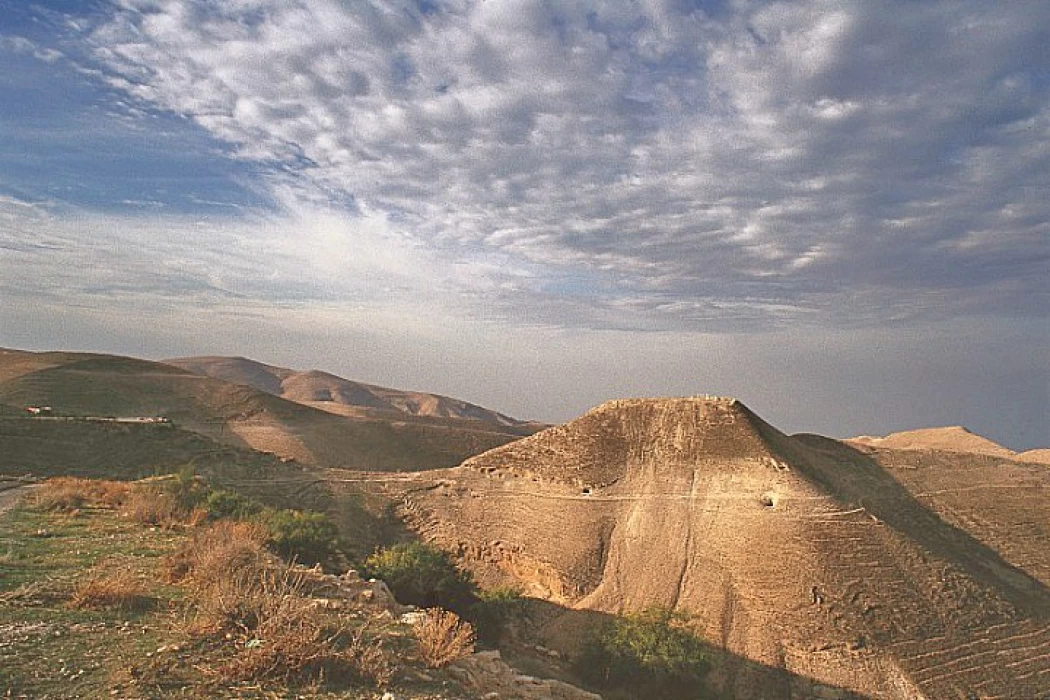
Mukawir: Herod's Majestic Fortress
City of Machaerus
The historic city of Machaerus is located 32 km southwest of Madaba and southeast of Ma'in Hot Springs. Its castle was built on a medium hill 730 m above sea level and overlooks the Dead Sea from the east. The mosaic inscription in the castle, which is the oldest mosaic piece, indicates that the builder of the castle is Alexander Jannaeus of the Maccabees, as it was built in 90 BC. It later became a strong center of resistance to the Romans, which prompted them to seize and destroy it in 57 BC. It remained this way until Herod the Great came to it, who took great interest in the place. So he increased its fortification.
Herod built a large city on its ruins and next to the castle. He rebuilt it again in the year (25-6 BC) and wanted it to be a fortified castle, so he surrounded it with a wall and high towers, and connected the city to the castle by a bridge. This great interest of Herod in the place can be explained by several reasons, including:
- To monitor the movements of the Nabataean Arabs in Petra due to the poor relations between them, and to repel Roman invasions.
- The location is close to the therapeutic volcanic waters of Zara.
- It provides cold fresh water.
After the death of Herod the Great, his son Herod Antipas took over the rule, and annexed it to his kingdom. After forty years, the Roman armies led by Lucilius Bassus came to suppress the Jewish revolt in Palestine (71-72 AD). After entering Jerusalem, the Jews fled to the neighboring castles, including Herodium Castle in eastern Bethlehem and Machaerus Castle, which prompted Lucilius Bassus to besiege Machaerus and occupy it.
Since the sixth century, according to the discovered artifacts, Christian monks came to “Khirbet Makawir” and settled there, and built their Byzantine churches, the remains of which still exist today. Makawir became a “Christian place” for the “Al Imran family” and a site for Christian pilgrimage until the ninth century AD, when it was destroyed and erased as a cultural center as a result of subsequent invasions.
The area was rediscovered in 1964 by the Franciscan Fathers Mission from Jerusalem. Archaeological excavations in the castle continued in 1968, where archaeological excavations focused on the castle, and its theater and the temple of the Prophet Yahya, peace be upon him, were discovered in the “Deir” area.
The historic city was not rebuilt within the framework of a national project to revive the city’s civilization to be a starting point for Christian pilgrimage until the Vatican chose “Macaor” as a holy Christian religious site in the year 2000 “for embracing” the family of Imran “and the center of the launch of the call of the Prophet Yahya bin Zakariya” “John the Baptist” who was born there.
The Mikaros Castle, which was named for the roundness of its citadel, and which was mentioned in the mosaic map of Madaba, is located on a conical hill 1125 meters above sea level. This castle is located near the Ma'in Hot Springs and the Mujib Reserve, overlooking the mountains of Palestine and the Dead Sea.
The remains of Herod's palace, which he built for rest and entertainment, the remains of churches, towers, the wall surrounding the castle, and some houses built at the bottom of the castle and on the slopes of the mountain for the families of the guards, and the ruins of the city destroyed by the earthquake that struck it as punishment for its people for the killing of the Prophet of God, Yahya bin Zakariya, still stand today.














